创面修复_TIME_原则及其意义
伤口处理TIME原则

清洗后处理措施
伤口评估
清洗完成后,对伤口进行评估,了 解伤口类型、大小、深度及污染程 度等信息,为后续处理提供依据。
止血处理
如有活动性出血,需采取相应止血 措施,如加压包扎、止血带等。
抗感染治疗
根据伤口情况,遵医嘱选用适当的 抗生素或外用药物进行抗感染治疗 ,预防伤口感染。
伤口包扎
选用无菌敷料对伤口进行包扎,保 护伤口免受外界污染和刺激。注意 包扎松紧度要适宜,以免影响局部 血液循环。
未来发展趋势预测
01
智能化伤口处理
随着人工智能技术的发展,未 来伤口处理可能实现智能化, 通过算法辅助医护人员进行快 速、准确的伤口评估和处理。
02
新型敷料研发
未来可能涌现出更多新型敷料 ,如生物活性敷料、智能敷料 等,以满足不同类型伤口的治
疗需求。
03
远程医疗应用
借助远程医疗技术,患者可在 家中进行伤口处理和护理,减 轻医院负担,提高患者生活质
快速评估伤口
TIME原则强调对伤口的快 速评估,有助于医护人员 迅速了解伤口情况,为后 续处理提供依据。
个体化治疗方案
根据TIME原则,针对不同 伤口类型和患者情况,制 定个体化的治疗方案,提 高治疗效果。
促进伤口愈合
TIME原则通过优化伤口处 理流程,有助于缩短伤口 愈合时间,减少并发症的 发生。
通过遵循TIME原则,医护人员 可以更加全面地评估患者的伤口 情况,制定个性化的治疗方案,
促进伤口的快速愈合。
02
评估伤口情况
伤口类型识别
01
清洁伤口
无感染迹象,边缘整齐,对合 良好。
02
污染伤口
有细菌沾染,但未构成感染。
03
1例皮肤损伤案例的治疗与体会
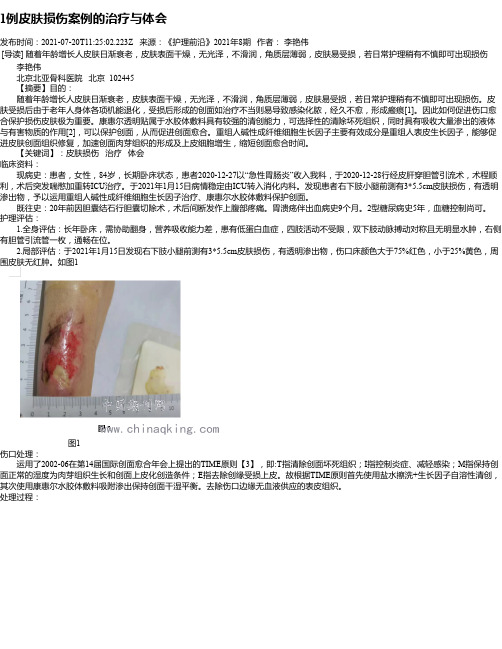
1例皮肤损伤案例的治疗与体会发布时间:2021-07-20T11:25:02.223Z 来源:《护理前沿》2021年8期作者:李艳伟[导读] 随着年龄增长人皮肤日渐衰老,皮肤表面干燥,无光泽,不滑润,角质层薄弱,皮肤易受损,若日常护理稍有不慎即可出现损伤李艳伟北京北亚骨科医院北京 102445【摘要】目的:随着年龄增长人皮肤日渐衰老,皮肤表面干燥,无光泽,不滑润,角质层薄弱,皮肤易受损,若日常护理稍有不慎即可出现损伤。
皮肤受损后由于老年人身体各项机能退化,受损后形成的创面如治疗不当则易导致感染化脓,经久不愈,形成瘢痕[1]。
因此如何促进伤口愈合保护损伤皮肤极为重要。
康惠尔透明贴属于水胶体敷料具有较强的清创能力,可选择性的清除坏死组织,同时具有吸收大量渗出的液体与有害物质的作用[2],可以保护创面,从而促进创面愈合。
重组人碱性成纤维细胞生长因子主要有效成分是重组人表皮生长因子,能够促进皮肤创面组织修复,加速创面肉芽组织的形成及上皮细胞增生,缩短创面愈合时间。
【关键词】:皮肤损伤治疗体会临床资料:现病史:患者,女性,84岁,长期卧床状态,患者2020-12-27以“急性胃肠炎”收入我科,于2020-12-28行经皮肝穿胆管引流术,术程顺利,术后突发喘憋加重转ICU治疗。
于2021年1月15日病情稳定由ICU转入消化内科。
发现患者右下肢小腿前测有3*5.5cm皮肤损伤,有透明渗出物,予以运用重组人碱性成纤维细胞生长因子治疗、康惠尔水胶体敷料保护创面。
既往史:20年前因胆囊结石行胆囊切除术,术后间断发作上腹部疼痛。
胃溃疡伴出血病史9个月。
2型糖尿病史5年,血糖控制尚可。
护理评估: 1.全身评估:长年卧床,需协助翻身,营养吸收能力差,患有低蛋白血症,四肢活动不受限,双下肢动脉搏动对称且无明显水肿,右侧有胆管引流管一枚,通畅在位。
2.局部评估:于2021年1月15日发现右下肢小腿前测有3*5.5cm皮肤损伤,有透明渗出物,伤口床颜色大于75%红色,小于25%黄色,周围皮肤无红肿。
袁宝芳:伤口处理TIME原则.ppt
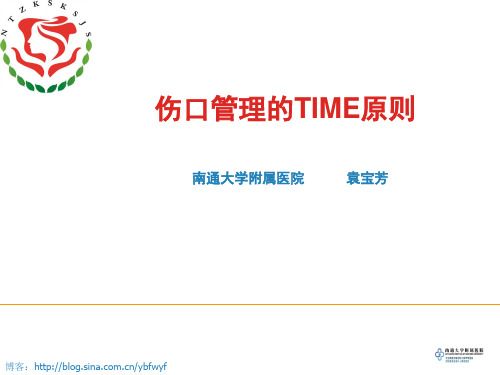
简单创面
博客:/ybfwyf
博客:/ybfwyf
I = 感染/炎症的控制 (Infection or Inflammation Control)
伤口内细菌侵害的程度可分为:
污染——伤口内存在着非复制
的细菌,但不影响伤口愈合。
定植——存在可复制的微生物,
但没有引起宿主的反应。
博客:/ybfwyf
博客:/ybfwyf
一、伤口床的准备
通过伤口的全面评估,可以局部判断该伤口是否 能够如期愈合。 如果预期伤口能够顺利愈合,这种伤口称为简单 伤口。
博客:/ybfwyf
伤口床的准备
如果预期有各种不确定因素影响伤口的愈合,这 种伤口称为复杂伤口。 伤口处理的目的和过程: 复杂伤口 简单伤口 促进伤口愈合
I = 感染/炎症的控制 (Infection or Inflammation Control)
伤口感染是影响伤口愈合的重要因素和障碍。 根据伤口内细菌数量,把细菌在伤口内的侵袭的 过程分为以下几步: 污染 (Contamination ) 定植 (Colonisation ) 严重定植 (Critical colonisation ) 感染( infection )
伤口管理的TIME原则
南通大学附属医院 袁宝芳
博客:/ybfwyf
伤口愈合概念
伤口愈合是一个自然的过程,从凝血开始,经 坏死组织、异物和细菌的清除等一系列过程,以 新生组织形成并填补伤口缺损结束,最终转化为 瘢痕。伤口的愈合涉及机体局部和整体的反应, 并受多种内源性和外源性因素的影响。
这一过程称为Βιβλιοθήκη 口床的准备博客:/ybfwyf
伤口床的准备
伤口床的准备:为了加速自体愈合或增强其他治疗 手段疗效而进行的伤口管理。 这一概念是2000年由一位美国学者提出,它为 难愈伤口提供了一种系统的、有步骤的治疗方法。 作为一个完整的伤口床准备过程应包括清创、
《多学科合作下糖尿病足防治专家共识》(2020版)全版》要点

《多学科合作下糖尿病足防治专家共识》(2020版)全版》要点《多学科合作下糖尿病足防治专家共识》(2020版)全版》要点1背景糖尿病足是糖尿病严重的并发症之一,合作具有较高的截肢和死亡风险,临床对其进行规范化诊疗很重要,而糖尿病足指南/共识的制定和践行能有力地提高这种规范化。
2糖尿病足的评估和诊断2.1进行全面医学评估【推荐1】:针对所有糖尿病足患者群,进行全面医学评估,尤其是心脑肾等重要脏器功能及其危险因素,以及下肢病变情况的评估(推荐程度为强,证据等级为低)2.2评估和诊断糖尿病感染(DFI)【推荐2】:DFI是基于局部或全身炎症症状和体征的临床诊断(推荐程度为强,证据等级为中等)。
【推荐 2.1】:若临床检查模棱两可或无法解释,考虑将炎症血清生物标志物,如CRP、ESR、PCT等作为辅助诊断,用于DFI诊断(推荐程度为强,证据等级为低)。
【举荐 2.2】:几乎所有临床感染的溃疡,都要收集其组织标本进行培养以确定致病菌(举荐程度为强,证据等级为中等)。
【推荐3】:存在深或大溃疡、骨突出部位溃疡或慢性不愈合溃疡等征象时,应高度怀疑骨髓炎可能,需要进一步做骨探针、X线片和核磁共振等检查(推荐程度为强,证据等级为中等)。
【推荐3.1】:在所有DFI患者群中,建议进行足部X线平片(PFR)检查,以确定骨异常(畸形、破坏)、软组织气体和异物(推荐程度为强,证据等级为中等)。
【举荐 3.2】:对疑心有软组织脓肿或糖尿病足骨髓炎(DFO)诊断尚不确定时,举荐使用磁共振成像(MRI)作为评价手段(举荐程度为强,证据等级为低);对疑心DFO而又不克不及行MRI检查者,建议骨扫描结合白细胞闪烁成像或抗粒细胞扫描(举荐程度为强,证据等级为低)。
【举荐3.3】:骨活检及骨组织细菌培养是DFO诊断金标准(举荐程度为强,证据等级为高)。
【举荐4】:DFI严重程度,建议使用IWGDF/IDSA的相关标准(举荐程度为强,证据等级为中等);脓毒症诊断标准,建议采用中华危重症医学分会的相关指南(举荐程度为强,证据等级为中等)。
伤口恢复的原则

伤口恢复的原则伤口恢复是指在受伤后,通过一系列的治疗和护理措施,使伤口愈合并恢复正常功能的过程。
伤口恢复的过程是一个复杂而重要的过程,它需要遵循一定的原则和方法,以促进伤口的愈合和恢复。
1.保持清洁:伤口恢复的首要原则是保持伤口的清洁。
清洁的环境可以减少细菌感染的风险,促进伤口的愈合。
在清洁伤口时,应使用温水和无刺激性的肥皂轻轻清洗,避免使用酒精和过于刺激的清洁剂。
2.止血控制:在受伤后,如果伤口出血,应立即采取控制出血的措施。
可以使用干净的纱布或绷带进行包扎,直到出血停止。
如果伤口出血严重或无法止住,应及时就医寻求专业的医疗救助。
3.避免感染:伤口感染是伤口恢复过程中常见的并发症之一。
为了避免伤口感染,应保持伤口的干燥和通风,并定期更换干净的敷料。
如果伤口发红、肿胀、渗液或有异常气味,应及时就医治疗。
4.促进愈合:为了促进伤口的愈合,可以采取一些措施。
例如,保持伤口处的湿润可以加速愈合,可以使用透明敷料或者适当的伤口愈合喷雾来实现。
此外,合理的营养摄入也是促进伤口愈合的重要因素,可以增加蛋白质和维生素的摄入。
5.避免拉扯:在伤口恢复的过程中,应避免拉扯伤口,以免破坏伤口的愈合。
特别是在伤口愈合初期,应避免过度活动或过度用力,以免引起伤口裂开或感染。
6.定期复查:伤口恢复过程中,定期复查是非常重要的。
医生会根据伤口的情况,评估伤口的愈合情况,并采取必要的治疗措施。
定期复查可以及时发现并处理伤口恢复过程中的问题,提高伤口愈合的效果。
7.合理使用药物:在伤口恢复过程中,根据伤口的情况和医生的建议,可以合理使用一些药物。
例如,可以使用抗生素药物预防感染,使用止痛药物缓解疼痛,或者使用促进伤口愈合的药物。
8.注意伤口保护:伤口恢复过程中,要注意保护伤口,避免再次受伤。
可以使用适当的包扎或者保护性器具来保护伤口,避免外界的撞击或压力。
9.心理支持:在伤口恢复过程中,心理支持也是非常重要的。
受伤后可能会带来一定的心理压力和焦虑,需要家人和朋友的关心和支持。
外科学题创面处理的原则与技巧

外科学题创面处理的原则与技巧在外科学中,创面处理是一项至关重要的技能,它涉及到对各种类型和程度的伤口进行适当的处理和修复。
准确的创面处理可以促进伤口的愈合,减少感染和并发症的发生。
本文将探讨外科学中创面处理的原则与技巧。
创面处理的原则:1. 消毒:处理创面前,必须首先进行彻底的消毒,以杀灭伤口表面的细菌和其他致病微生物。
可以使用适当的消毒剂,如碘酒或氯己定溶液,来清洁和消毒创面。
2. 血止血:在处理出血性创面时,及时止血是至关重要的。
可以使用压迫或缝合技术来控制出血,并恢复血液循环。
3. 创面清创:对于深度较大或有明显污染的创面,应该进行彻底的清创。
清创是指清除伤口周围的坏死组织、异物和病理组织,以促进创面的愈合和新鲜组织的生长。
4. 缝合技术:在进行创面缝合时,应该选用适当的缝合材料和技术。
可以根据伤口的大小、位置和张力选择单层缝合、多层缝合或特殊缝合技术,以实现创面的牢固闭合和恢复。
5. 创面保护:在处理完创面后,应该给予创面适当的保护。
可以使用敷料或绷带来覆盖和固定创面,以防止感染和损伤。
创面处理的技巧:1. 辨别创面类型:在处理伤口前,需要准确地判断创面的类型和程度。
可以通过观察创面的大小、形状、深度和出血情况,来确定合适的处理方法。
2. 创面清洁:在处理创面前,必须先将创面周围的皮肤进行彻底的清洁。
可以使用清洁剂或消毒液轻柔地擦拭和清洗创面周围的皮肤,以减少感染风险。
3. 小创面处理:对于较小的创面,可以采用局部止血和简单缝合的方法进行处理。
局部止血可以通过压迫或使用止血剂来达到,而简单缝合则可以使用缝线或无损缝合技术来完成。
4. 大创面处理:对于较大的创面,可能需要进行更复杂的处理方法,如多层缝合、皮瓣转移或自体组织移植等。
这些方法需要经验丰富的外科医生来执行。
5. 伤口愈合观察:在处理完创面后,需要密切观察创面的愈合情况。
如果出现创口红肿、渗液、发热或疼痛等异常症状,应及时就医进行评估和处理。
伤口处理TIME原则

处理的目标:促进伤口的湿润平衡,选择适 合的敷料能对渗液进行有效管理,可以在伤 口表面保持一定的湿度,还可控制水分的吸 收和蒸发。
E =伤口边缘 (Edge of wound)
? 伤口干燥时,伤口边缘的上皮化和再修复 就会迟缓,伤口边缘就会出现坏死组织和 结痂。
污染 (Contamination ) 定植 (Colonisation ) 严重定植 (Critical colonisation ) 感染( infection )
I = 感染/炎症的控制 (Infection or Inflammation Control)
伤口内细菌侵害的程度可分为 :
污染——伤口内存在着非复制
伤口管理的TIME原则
天津中医药一个自然的过程,从凝血 开始,经坏死组织、异物和细菌的清除等 一系列过程,以新生组织形成并填补伤口 缺损结束,最终转化为瘢痕。伤口的愈合 涉及机体局部和整体的反应,并受多种内 源性和外源性因素的影响。
一、伤口床的准备
通过伤口的全面评估,可以局部判断该伤口是否能够如 期愈合。 如果预期伤口能够顺利愈合,这种伤口称为简单伤口。
作为一个完整的伤口床准备过程应包括清 创、抗感染、渗液的管理和伤口边缘的处理, 即按照 TIME 原则来进行。
二、伤口管理的原则(TIME)
TIME 首字母缩写词 , 概括了伤口管理的原则 : ? T = Tissue assessment and the management of nonviable tissue or tissue deficits 伤口组织的评价和组织坏死、组织缺损的处 理。 ? I = Infection or inflammation control 控制感染或炎症 ? M = maintenance of Moisture balance 保持伤口的湿润平衡
创面修复

(2)保护创面,防止细菌感染,减少出血
(3)机化血块和坏死组织及其他异物由于新生健康的肉芽组织外观呈鲜红色,因此,临床上又将此时的创面 称之为红色期。随着肉牙组织的不断形成,创面组织的缺失被填充,上皮细胞便从创面周缘向中心移行,最终使 得创面得以完全被再生的上皮细胞覆盖。
感谢观看
炎症期(Inflammation phase)
这一时期自创面形成开始的前2-3天。由于局部血管的收缩,导致局部组织缺血,引起组织胺(Histamine) 和其他血管活性物质的释放,使创面局部的血管扩张;同时,因坏死组织,以及可能的致病微生物的存在,引发 机体的防御反应(炎症反应):免疫细胞如粒细胞和巨噬细胞向创面移动和集中。
修复期(Reconstruction phase)
这一时期又可以分为2个阶段:上皮再生(Epithelialisation)和肉芽组织形成(Granulation)。也称之 为增生期(Proliferation)。这一时期约从创面形成后的2-24天。v上皮细胞再生创面修复首先是创面周缘健 存的基底细胞开始增生,并向中心部位移行。与此同时,基底细胞的增殖刺激创面基底部毛细血管和结缔组织的 反应性增生。当创面被新生的上皮细胞覆盖后,创面外观呈粉红色,故而又称此时的创面为粉红色期。v肉芽组织 形成随后,基底细胞的增生刺激肉芽组织的生长。同时,巨噬细胞释放的生长因子如血小板衍生生长因子 (PDGF),β转型生长因子(β-TGF)和α转型生长因子(α-TGF)等,加速肉芽组织的形成。肉芽组织的形成 有着重要的生物学意义,主要表现为:
II真皮层(Dermis)该层可分为乳头状层(Papillary layer)和状层(Reticular layer)二层。真皮层富 含血管和神经末梢、淋巴管、结缔组织和胶原蛋白,是表皮的支撑结构,同时也是表皮与皮下组织的连接结构。
TIME在慢创中的应用

I = 感染/炎症的控制
伤口内细菌侵害的程度可分为:
污染/定 植
严重定 植/ 局 部感染
感染
细菌数量的增加=临床感染体征的增加
细菌数量
I = 感染/炎症的控制
脓肿、渗出、蜂窝组织炎、坏疽
组织塌陷、红肿加重、分泌物增多 渗出物气味、疼痛、腐肉坏死组织 白细胞计数改变、发热、菌血症 C---反应蛋白
压 疮
静脉溃疡
糖尿病足
术后切口延迟愈合
慢性伤口处理的里程碑
近年来 20世纪80年代 20世纪60-70年代
湿性 愈合
机体中的 多种生长 因子对创 面具有极 强的修复 作用
创面床准备 (wound bed preparatio n WBP)
什么是伤口床准备?
伤口床准备的概念最早是由Falanga提出的,他提出的 TIME伤口处理方法已经受到越来越多人的认可,在临床 中也得到普及
TIME原则 ----慢性伤口应用
慢性伤口定义
有关急性/慢性伤口的定义尚未有统一标准。一般认为急 性伤口是指自外力造成的前2周内能愈合的所有伤口。之 后,由于某些不利的影响因素如感染、异物等导致伤口愈 合过程受阻,愈合过程部分或完全停止,使伤口愈合时间 超过2周,这时的伤口称为慢性伤口
常见的慢性伤口
复杂 创面
Wound-bed Preparation – 伤口床准备
“复杂” 创面
“伤口床”准备
T
软组织处理
I
抗感染处理
M
渗液的管理
E
创缘的处理
伤口床 准备完成
“普通”创面
伤口管理的原则 (TIME)
TIME 首字母缩写词, 概括了伤口管理的原则: T = Tissue assessment and the management of nonviable tissue or tissue deficits 伤口组织的评价和组织坏死、组织缺损的处理 I = Infection or inflammation control 控制感染或炎症 M = maintenance of Moisture balance 保持伤口的湿润平衡 E = the promotion of epithelial advancement of wound Edges 促进伤口边缘的上皮化进程
创面处理的基本的原则

创面处理的基本原则概述
清洁和消毒
保持创面清洁,使用适当的消毒剂进 行消毒,以减少感染的风险。
02
止血
控制出血,避免因失血过多引起休克 或贫血。
01
预防并发症
注意观察创面的变化,及时处理可能 出现的问题,如感染、水肿、淤血等。
05
03
促进愈合
使用适当的敷料和药物,为创面提供 湿润的环境,促进细胞生长和新生血 管的形成,加速创面愈合。
循环。
抬高受伤部位
通过将受伤部位抬高至心脏水平 以上,利用重力帮助减少出血。 适用于四肢等部位的外伤出血。
止血带止血
在伤口近心端使用止血带,暂时 阻断血流。需注意止血带不能过 紧,应标记上止血带放置时间,
并定期放松,防止肢体坏死。
止痛的常用药物和注意事项
非处方止痛药
如对乙酰氨基酚(如扑热息痛)或非甾体抗炎药(如布洛芬),适用于轻至中 度疼痛。注意事项包括遵循药物剂量和用药间隔,避免长期使用或滥用。
消毒的方法和注意事项
01
02
03
碘伏消毒
碘伏具有广谱杀菌作用, 刺激性小,使用方便。使 用时应注意避免碘过敏和 损伤正常组织。
酒精消毒
酒精具有杀菌作用,但刺 激性较大,不宜用于破损 皮肤和黏膜。
其他消毒剂
如洗必泰、新洁尔灭等, 使用时应遵循说明书,避 免过敏和损伤。
清洁与消毒的步骤
准备工具
清洗创面
止痛处理
观察与记录
根据疼痛程度选择适当的止痛药物,轻度 疼痛可选用非处方药,中度至重度疼痛需 在医生指导下使用处方药。
在止血和止痛过程中,应密切观察病情变 化,记录出血量、疼痛程度和用药情况, 以便及时调整治疗方案。
04 包扎与固定
创面愈合的基本理论
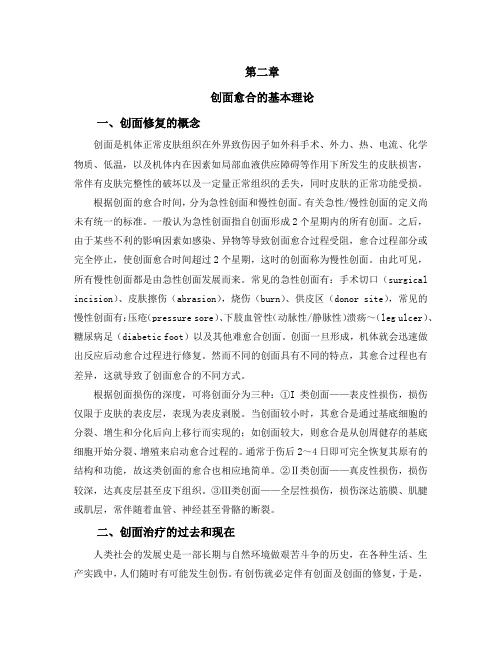
第二章创面愈合的基本理论一、创面修复的概念创面是机体正常皮肤组织在外界致伤因子如外科手术、外力、热、电流、化学物质、低温,以及机体内在因素如局部血液供应障碍等作用下所发生的皮肤损害,常伴有皮肤完整性的破坏以及一定量正常组织的丢失,同时皮肤的正常功能受损。
根据创面的愈合时间,分为急性创面和慢性创面。
有关急性/慢性创面的定义尚未有统一的标准。
一般认为急性创面指自创面形成2个星期内的所有创面。
之后,由于某些不利的影响因素如感染、异物等导致创面愈合过程受阻,愈合过程部分或完全停止,使创面愈合时间超过2个星期,这时的创面称为慢性创面。
由此可见,所有慢性创面都是由急性创面发展而来。
常见的急性创面有:手术切口(surgical incision)、皮肤擦伤(abrasion),烧伤(burn)、供皮区(donor site),常见的慢性创面有:压疮(pressure sore)、下肢血管性(动脉性/静脉性)溃疡~(leg ulcer)、糖尿病足(diabetic foot)以及其他难愈合创面。
创面一旦形成,机体就会迅速做出反应后动愈合过程进行修复。
然而不同的创面具有不同的特点,其愈合过程也有差异,这就导致了创面愈合的不同方式。
根据创面损伤的深度,可将创面分为三种:①I类创面——表皮性损伤,损伤仅限于皮肤的表皮层,表现为表皮剥脱。
当创面较小时,其愈合是通过基底细胞的分裂、增生和分化后向上移行而实现的;如创面较大,则愈合是从创周健存的基底细胞开始分裂、增殖来启动愈合过程的。
通常于伤后2~4日即可完全恢复其原有的结构和功能,故这类创面的愈合也相应地简单。
②Ⅱ类创面——真皮性损伤,损伤较深,达真皮层甚至皮下组织。
③Ⅲ类创面——全层性损伤,损伤深达筋膜、肌腱或肌层,常伴随着血管、神经甚至骨骼的断裂。
二、创面治疗的过去和现在人类社会的发展史是一部长期与自然环境做艰苦斗争的历史,在各种生活、生产实践中,人们随时有可能发生创伤。
外科学创面修复技术简介

根据创面性质和治疗手段的不同,创面修复技术可分为传统创面修复技术和现代 创面修复技术两大类。传统创面修复技术主要包括清创、缝合、包扎等,而现代 创面修复技术则包括湿性愈合、负压封闭引流、生物材料应用等。
发展历程及现状
发展历程
创面修复技术的发展经历了漫长的历史过程。早在古代,人们就开始使用各种自然物质如蜂蜜、动物油脂等涂抹 伤口以促进愈合。随着医学科学的进步,创面修复技术不断得到改进和完善,逐渐形成了现代创面修复技术的体 系。
01
02
03
局部因素
包括创面感染、异物残留 、局部血液循环障碍、神 经支配受损等。
全身因素
包括年龄、营养状况、免 疫功能、激素水平、药物 使用等。
其他因素
如吸烟、饮酒、心理压力 等也会对创面愈合产生不 良影响。
促进创面愈合的措施
彻底清创
清除创面上的异物、坏死组织及不健 康的肉芽组织,为创面愈合创造良好 条件。
心理干预
对患者进行心理干预,减轻其焦虑、 抑郁等不良情绪,提高患者的治疗依 从性和生活质量。
01
02
控制感染
合理使用抗生素,控制创面感染,促 进炎症消退。
03
改善局部血液循环
采用理疗、按摩等方法,改善创面局 部血液循环,促进新生血管形成和细 胞增生。
05
04
营养支持
给予患者足够的营养支持,包括蛋白 质、维生素、矿物质等,促进创面愈 合。
颅脑外伤创面处理
应用清创、止血、去骨瓣减压等创面修复技术,处理颅脑外伤创 面,降低颅内压,挽救患者生命。
脑脊液漏修补
采用自体组织或人工材料修补脑脊液漏,防止颅内感染。
头皮缺损修复
应用皮瓣转移、植皮等创面修复技术,修复头皮缺损,恢复患者 外观。
伤口管理TIME原则

TIME原则治疗总结
Tissue
• 溶痂 • 清创、引流
Infection • 抗感染,吸收渗液
Moisture
• 吸收渗液 • 封闭+保湿
Edge of wound
• 预防浸渍,保护上皮
案例分享
11.8 11.12
11.16
11.28
12.2 12.6
12.12
12.27
红、肿、热、痛
感染伤口管理
➢ 吸收渗出液,减少细菌繁殖 ➢ 抗感染,杀灭细菌 ➢ 降低浸渍,减少创周炎症反应 ➢ 降低再创伤,阻止创面扩大
• 直接作用 • 银离子杀菌
• 间接作用
• 高渗盐吸附细 菌及坏死物
银离子敷 料
美盐
M 湿性平衡
保持正确的最佳湿性平衡环境
保持伤口恒定的温湿度利于创面愈合
伤口湿性愈合=适度湿润的环境+密闭环境
太干
过湿
湿性平衡管理
选择合适的敷料很重要
✓ 良好的吸收性敷料 ✓ 兼具保湿效果 ✓ 减少创周浸渍 ✓ 无创性揭除
创周浸渍
E 伤口边缘上皮化
➢ 健康生长的肉芽组织
➢ 促进肉芽生长
➢ 健康活力的创缘皮肤
➢ 减少创周浸渍及损伤
➢ 保护脆弱上皮,避免再损伤
促进健康肉芽组织生长
➢ 创造湿性平衡的环境 ➢ 提供良好的生理环境 ➢ 减少创周上皮再损伤
引流
引估 法
无活性组 织
清创
引流
清创
➢ 手术或锐器清创法 ➢ 物理清创 ➢ 生物酶 ➢ 自溶痂 ➢ 生物学
黑色痂皮 黄色腐肉
混合坏死组织
Ⅰ感染控制/炎症控制
慢性伤口感染特性
1. 伤口腐肉增多 2. 渗出增多,渗液颜色粘稠度 3. 肉芽生长色泽污秽 4. 创周发红,发热 5. 糖尿病患者突然血糖升高 6. 疼痛 7. 异味 8. 伤口变大或出现新的损伤
创面修复TIME原则在1例截瘫患者压疮护理中的应用体会

DOI:10.19791/j.cnki.1006 6411.2021.10.068工作单位:1.266300 胶州 山东省胶州人民医院门诊部;2.266071 青岛 青岛海军九七一医院皮肤科邱天真:女,本科,护师逄凤:通信作者收稿日期:2019-08-07※个案护理创面修复TIME原则在1例截瘫患者压疮护理中的应用体会邱天真1 逄 凤2关键词:压力性损伤;截瘫患者;TIME原则;负压治疗;伤口护理 压力性损伤是指位于骨隆突处、医疗或其他器械下的皮肤和(或)软组织的局部损伤。
截瘫患者由于受损伤平面以下肢体运动功能、感知觉、运动等消失,膀胱、肛门括约肌功能丧失,致使局部组织长期受压以及大小便刺激,7.9%的脊髓骨折伴截瘫患者伴有压力性损伤[1]。
2002年6月在第14届国际创面愈合年会上,致力于创面修复的Sibbald等学者根据目前对创面愈合机制的认识和创面治疗经验的总结提出创面处理的TIME原则,即:T(tissue)指清除创面坏死组织;I(infection/inflammation)是指控制炎症、减轻感染;M(moisture)指保持创面正常的湿度,为肉芽组织生长和创面上皮化创造条件;E(edge/epithelialization)指去除创缘迁移受损的表皮。
TIME原则作为一个有价值的创面处理指导工具,获得了临床医生的好评,并被广泛应用于临床实践中[2]。
2018年8月22日本院收治了1例截瘫合并不可分期压力性损伤患者,对其运用TIME原则并配合封闭式负压引流技术,在治疗和护理98d后,患者创面愈合,现报道如下。
1 临床资料患者,男,58岁,2018年8月22日因骶尾部及臀部压疮2个月余就诊于本院,被诊断为“骶尾、臀、髂部多发压疮”,并收治于本院。
约半年前因外伤伤及胸椎椎体及脊髓,造成T9以下截瘫,运动感觉均丧失,大小便失禁,生活不能自理。
患者约2个月余前因骶尾、臀部长期受压,出现骶尾部及臀部多处皮肤破溃、坏死。
清创方法及分类
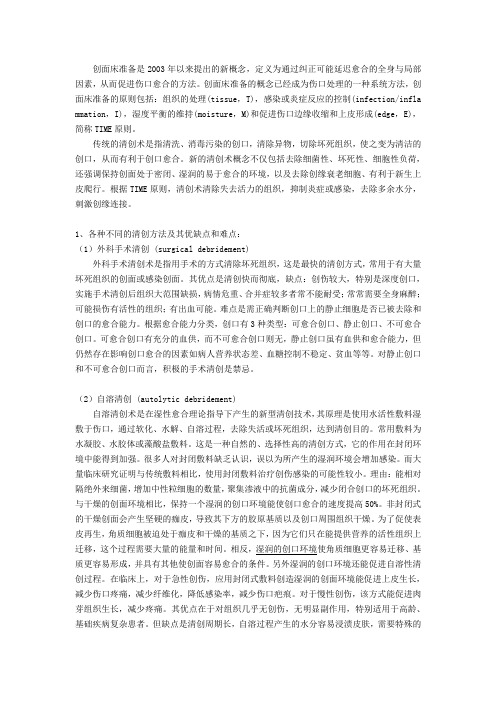
创面床准备是2003年以来提出的新概念,定义为通过纠正可能延迟愈合的全身与局部因素,从而促进伤口愈合的方法。
创面床准备的概念已经成为伤口处理的一种系统方法,创面床准备的原则包括:组织的处理(tissue,T),感染或炎症反应的控制(infection/infla mmation,I),湿度平衡的维持(moisture,M)和促进伤口边缘收缩和上皮形成(edge,E),简称TIME原则。
传统的清创术是指清洗、消毒污染的创口,清除异物,切除坏死组织,使之变为清洁的创口,从而有利于创口愈合。
新的清创术概念不仅包括去除细菌性、坏死性、细胞性负荷,还强调保持创面处于密闭、湿润的易于愈合的环境,以及去除创缘衰老细胞、有利于新生上皮爬行。
根据TIME原则,清创术清除失去活力的组织,抑制炎症或感染,去除多余水分,刺激创缘连接。
1、各种不同的清创方法及其优缺点和难点:(1)外科手术清创 (surgical debridement)外科手术清创术是指用手术的方式清除坏死组织,这是最快的清创方式,常用于有大量坏死组织的创面或感染创面。
其优点是清创快而彻底,缺点:创伤较大,特别是深度创口,实施手术清创后组织大范围缺损,病情危重、合并症较多者常不能耐受;常常需要全身麻醉;可能损伤有活性的组织;有出血可能。
难点是需正确判断创口上的静止细胞是否已被去除和创口的愈合能力。
根据愈合能力分类,创口有3种类型:可愈合创口、静止创口、不可愈合创口。
可愈合创口有充分的血供,而不可愈合创口则无,静止创口虽有血供和愈合能力,但仍然存在影响创口愈合的因素如病人营养状态差、血糖控制不稳定、贫血等等。
对静止创口和不可愈合创口而言,积极的手术清创是禁忌。
(2)自溶清创 (autolytic debridement)自溶清创术是在湿性愈合理论指导下产生的新型清创技术,其原理是使用水活性敷料湿敷于伤口,通过软化、水解、自溶过程,去除失活或坏死组织,达到清创目的。
创面处理的基本原则
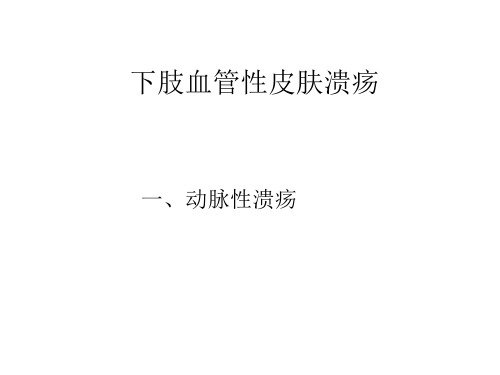
治疗方案
二、手术治疗 病因治疗,目的是减除静脉淤积。 1.浅静脉手术:大部分静脉溃疡有浅静脉反流,切除反流的 浅静脉,可以促进溃疡愈合。有剥脱、激光、射频等手术 方法。 2.深静脉瓣膜成形术:针对深静脉反流的手术,目的是降低 下肢深静脉因瓣膜功能不全引起的静脉高压。包括瓣膜修 补术、瓣膜重建或替代瓣膜等手术。 3.交通支静脉阻断:针对交通静脉功能不全,目的是阻断交 通静脉内的异常反流。常用腔镜下深筋膜交通支离断术。 三种手术方式术后均采用弹力袜或弹力绷带。 4.创面手术治疗: 植皮、皮瓣移植等。术后弹力绷带加压。
目的: 1.静脉逆流的程度与范围; 2.是否伴有静脉回流障碍及其定位; 3.病因诊断,原发性或继发性; 4.有肢体浮肿的,需明确是否由淋巴系统疾病引 起。
方法: 1.超声多普勒:无创,可观察瓣膜活动形态和活动 情况,可以反应深浅静脉系统是否有阻塞或反流。
2.下肢静脉造影检查:有创,是下肢静脉系统疾病 诊断的“金标准”,可以直观的反映深浅静脉主 干通畅程度,静脉瓣膜位置、数量、形态和结构, 对辨别交通静脉病变具有重要价值。
治疗方案
2.创面处理:遵循TIME模式。 T (Tissue management, 允许反复清创,以“蚕食”方式清除明显坏死组 织。对于血管病变为主的伤口则首先行血管相关 伤口组织处理)
治疗。伤口的保护以避免感染为主,采取干性疗 法,即使无法进行血管手术,也可通过这种方法 可自行干性坏疽脱离。 伤口的清洁(生理盐水) 局部抗菌药物(碘、银制剂,莫匹罗星) 全身抗菌药物(蜂窝织炎、淋巴结炎、骨髓炎等) 保持伤口湿性可以加速伤口上皮化。但在血管问 题解决之前,一般建议干性治疗。
使用弹力绷带和弹力袜注意事项: (1)清晨,下床前穿戴包扎好,晚上上床前 脱下; (2)穿戴时抬高患肢; (3)弹力绷带:松紧适中,以能一手指伸入 为度。露趾,便于观察;从远端向近端包 扎。
创面愈合

1.1 皮肤的正常结构皮肤,包括其附属结构如毛发、指甲、皮脂腺以及汗腺等,是人体最大的器官。
在成年人,平均来说,全身皮肤面积约有7600平方厘米,占整个体重的15%,而且约有1/3的循环血量是供应到皮肤的(Vn De Grff, 1986)。
身体不同部位的皮肤厚度也不尽相同,从最薄的0.04mm(眼睑部)到最厚的1.6mm(手掌及脚掌部)。
v pH值在4.2 - 5.6之间(Brynt, 1987)。
皮肤是机体与自然界之间的第一道屏障,其主要功能是保护作用,防止环境致病微生物的入侵以及自身体液的丢失。
同时,皮肤也具有感觉、交换以及体温调节等作用。
然而,我们也可以通过皮肤了解个体的健康状况、心理状态、年龄、种族和文化背景等。
因此,可以说,皮肤是机体的一个非常重要的器官。
组织结构上,皮肤由外至内可以分为三层,即表皮层(Epidermis)、真皮层(Dermis)以及皮下组织(Hypodermis)。
I 表皮层(Epidermis)表皮是皮肤的最外层,厚度约0.04mm,不含血管,其营养是靠基底层细胞供给。
在显微镜下,表皮又可以分为五个层次,从基底开始依次为:,基底层(Strtum germintivum)b,棘细胞层(Strtum spinosum)c,颗粒层(Strtum grnulosum)d,透明层(Strtum lucidum)e,角质层(Strtum corneun)表皮的最外层是角质层,这一层是皮肤发挥保护功能的重要保障,而且这一层的细胞会不断地脱落,同时,基底层细胞不断分裂增生,向角质层推移,补充脱落的细胞,这个过程正常情况下约需28天。
这一时间称为更替时间(Turnover time)。
这一时间常常在皮肤病理状态或者外界因素的作用下发生改变,从而导致皮肤疾病,如皮肤橡皮样病变等。
上皮细胞这种分裂增殖与移行能力是创面愈合得以完成的重要保障。
II 真皮层(Dermis)该层可分为乳头状层(Ppillry lyer)和网状层(Reticulr lyer)二层。
- 1、下载文档前请自行甄别文档内容的完整性,平台不提供额外的编辑、内容补充、找答案等附加服务。
- 2、"仅部分预览"的文档,不可在线预览部分如存在完整性等问题,可反馈申请退款(可完整预览的文档不适用该条件!)。
- 3、如文档侵犯您的权益,请联系客服反馈,我们会尽快为您处理(人工客服工作时间:9:00-18:30)。
中国组织工程研究第16卷第11期 2012–03–11出版Chinese Journal of Tissue Engineering Research March 11, 2012 Vol.16, No.11 ISSN 1673-8225 CN 21-1581/R CODEN: ZLKHAH2059创面修复“TIME”原则及其意义****★◆徐媛,刘宏伟“TIME” principles and its clinical significance in wound repair Xu Yuan, Liu Hong-weiAbstractBACKGROUND: While the cellular and molecular mechanisms of wound healing have been understood gradually and theexperiences of wound bed management have been accumulated, the importance of wound bed preparation to wound repair hasrecently attracted more attention.OBJECTIVE: To fully analyze the mechanisms of wound healing, various influence factors and their effects in this progress.METHODS: An on line search of CNKI and PubMed databases was performed for articles published between 1994 and 2011,using key words of “TIME principles, wound bed preparation, wound healing” in Chinese and English, respectively. The clinicalapplication principles and outcomes of wound healing were analyzed.RESULTS AND CONCLUSION: A total of 498 papers were collected, and 24 of them were included according to inclusive criteria.TIME is the initials of four principles in wound bed management. T means to remove the necrotic tissue. I means to control theinfection and to reduce the inflammation. M means to keep the wound moisture under normal condition for the granulation tissuegrowth and re-epithelialization. E means to remove non migrating epidermis at the edge of wound. As a valuable guidance tool forwound management, the TIME concept has been applied to clinical practice, and has been widely appreciated by clinicans.Xu Y, Liu HW. “TIME” principles and its clinical significance in wound repair. Zhongguo Zuzhi Gongcheng Yanjiu. 2012;16(11):2059-2062. [ ]摘要背景:随着人们对创面愈合机制研究的深入和创面处理经验的积累,创床的准备对于创面修复的重要性越来越引起人们的高度重视。
目的:全面了解创面愈合的机制,明确影响创面愈合的各种影响因素及其作用。
方法:电子检索中国期刊全文数据库(1994/2011)和 PubMed 数据库(1994/2011),检索词分别为“TIME原则,创面准备,创面愈合”和“TIME principles, wound bed preparation, wound healing”,语言分别设定为中文和英文,分析创面愈合临床应用原则及效果的研究进展。
结果与结论:共检索到文献 498 篇,阅读标题和摘要后,按纳入标准,共纳入22篇。
TIME为创面处理过程中创床准备4项原则性的方法的首个英文字母的缩写,即:T指清除创面坏死组织(tissue);I指控制炎症、减轻感染(infection/inflammation);M指保持创面正常的湿度为肉芽组织生长和创面上皮化创造条件(moisture);E 指去除创缘迁移受损的表皮(edge of wound,non migrating)。
目前TIME原则作为一个有价值的创面处理指导工具受到临床医生的好评,并应用于临床实践。
关键词:创伤愈合;溃疡;清创;慢性创面;创面分析doi:10.3969/j.issn.1673-8225.2012.11.037徐媛,刘宏伟.创面修复“TIME”原则及其意义[J].中国组织工程研究,2012,16(11):2059-2062.[ ]0 引言创面修复是指由于各种因素造成皮肤组织缺损后,通过自身组织的再生、修复、重建或人为进行干预治疗,从而达到创面愈合目的的一系列过程。
随着人们对创面愈合机制研究的深入和创面处理经验的积累,创床的准备对于创面修复的重要性越来越引起人们的高度重视。
2002-06在第14届国际创面愈合年会上,致力于创面修复的Sibbald等[1]学者根据目前对创面愈合机制的认识和创面治疗经验的总结提出了创床准备的TIME原则。
TIME为创面处理过程中创床准备四项原则方法的首个英文字母的缩写,即:T指清除创面坏死组织(tissue);I指控制炎症、减轻感染(infection/ inflammation);M指保持创面正常的湿度为肉芽组织生长和创面上皮化创造条件(moisture);E指去除创缘迁移受损的表皮(epidermis, nonmigrating)。
这4项创面处理的原则最早于2003年初以表格的形式发表在《Wound Repair and Regeneration》杂志,2003-09又进行了修订,将“epidermis”改成了“edge of wound”[2]。
TIME原则作为一个有价值的创面处理指导工具受到临床医生的好评,并应用与临床实践。
本文着重阐述了TIME原则提出的历史背景及临床意义。
Department of PlasticSurgery, the FirstAffiliated Hospital ofJinan University, KeyLaboratory forRegenerativeMedicine, Ministry ofEducation,Guangzhou510630, GuangdongProvince, ChinaXu Yuan★, Master,Physician,Department of PlasticSurgery, the FirstAffiliated Hospital ofJinan University, KeyLaboratory forRegenerativeMedicine, Ministry ofEducation,Guangzhou510630, GuangdongProvince, Chinayuan_xu@foxmail.comCorrespondingauthor: Liu Hong-wei,Associate chiefphysician, Doctoralsupervisor,Department of PlasticSurgery, the FirstAffiliated Hospital ofJinan University, KeyLaboratory forRegenerativeMedicine, Ministry ofEducation,Guangzhou510630, GuangdongProvince, Chinaliuhongwei0521@Supported by: theNational Programmefor Development ofKey FoundamentalResearch, No.2005CB522603*; theNational NaturalScience Foundationof China, No.30772257*,30973127*; theSpecial Funds forFoundamentalScientific Researchof the Central HigherEducationInstitutions, No.21611416*Received: 2011-07-09Accepted: 2011-07-21徐媛,等.创面修复“TIME ”原则及其意义P .O. Box 1200, Shenyang 110004 2060www.CRTER .org1 资料和方法1.1 资料来源 由第一作者用计算机检索中国期刊全文数据库(CNKI :1994/2011)和 PubMed 数据库(1994/2011),检索词分别为“TIME 原则,创面准备,创面愈合”和“TIME principles, wound bed preparation, wound healing ”,语言分别设定为中文和英文。
1.2 入选标准 ①针对性强、相关度高且与临床处理措施促进创面愈合联系紧密的文章。
②对同一领域的文献选取近期或权威杂志发表的文献。
1.3 数据的提取 由第一作者提取和分析文献。
初选共检索到文献 498 篇,阅读标题和摘要,按入选标准筛选,保留 23篇,手检1篇,最后共纳入 22 篇文献。
纳入的文献包括创面愈合机制及创面准备相关文献9篇[1-9],TIME 原则背景相关文献 1篇[1],TIME 原则促进创面愈合机制及临床研究 13 篇[10-22]。
依据TIME 原则提出的背景,TIME 原则的概念及TIME 原则与创面愈合的关系进行归纳总结。
